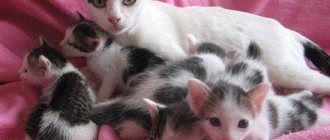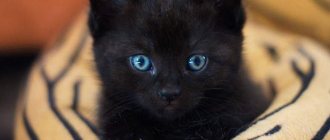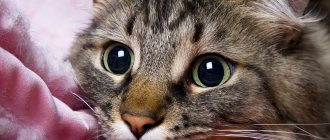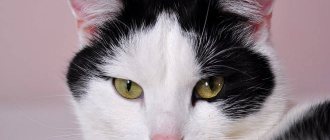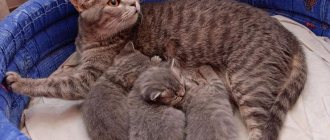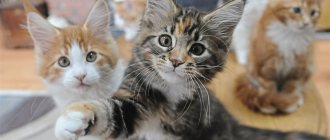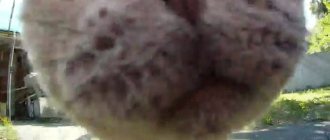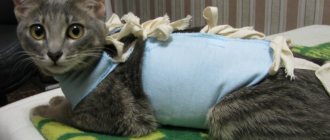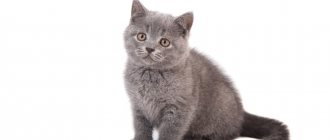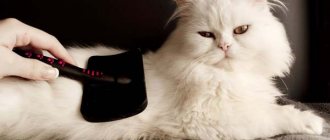Before getting a cat, you should thoroughly prepare for the new resident in the house. Even before the animal gets into the home, you need to purchase some items for a comfortable stay together.
The following auxiliary things will help ensure proper care for a Scottish Fold kitten:
- Bowls for water and drinking made of quality material, preferably porcelain or stainless steel.
- Food recommended by the breeders from whom the pet will be purchased.
- Tray and filler to which the animal is accustomed in the nursery. Later, it will be possible to change the toiletries to something more convenient for the owner, but for comfortable adaptation, the animal should first be provided with familiar items.
- A carrier for visits to the veterinarian and ease of movement with the kitten.
Other hygiene items can be purchased as needed.
▲ to contents
Scottish fold sleeping place
The sleeping place should be quiet and calm so that the kitten can fully rest.
Choose a mattress no wider than 10 centimeters, not too soft. It is acceptable to use a sheep's wool ski mat or a special bed for kittens as a sleeping place. You can also buy or make your own house for a kitten. Its frame is cut out of thick cardboard, which can be wrapped with padding polyester, cotton wool or other soft material, and covered with natural fabric, for example, chintz sewing scraps. In such a house, a fold-eared cat can comfortably sleep.
Scottish Fold kittens are peaceful, curious and people-oriented creatures. With the right approach to education and care, you will get a devoted, intelligent and ready to help you in everything four-legged friend.
What affects health
It is strictly forbidden to breed two fold-eared pets. As a result of such crossing, sick, weakened kittens are born. When purchasing, it is important to carefully study the cat’s pedigree and conduct an examination to identify possible defects and diseases.
At the first sign of illness, contact a veterinary clinic, where you must also obtain the animal’s vaccination schedule. We must not forget to monitor the condition of the ears: due to the peculiarities of their formation (ears are bent in half) and improper care, complications can arise. After bathing, you should not keep your baby in a draft.
Feeding
Choose the type of feeding:
- natural nutrition, this includes lean meats, fermented milk products, cereals and boiled vegetables;
- industrial food, for every age and specific situation (neutered cat, old cat, pregnant, lactating or kitten) there is its own option;
- mixed nutrition.
Many experts do not welcome a mixed diet. It is recommended to choose a natural or factory-made option for feeding Scottish Fold kittens.
Scottish Straight Longhair Highland Straight cat
Hygiene
Even small kittens that have not been taken from their mother have their eyes and muzzle washed and their ears cleaned. The eyes are wiped with a cotton pad soaked in ordinary warm water. Change the tampon and wipe your nose and mouth.
For the ear cleansing procedure, buy a special oil or use baby oil for the body. Dipping a cotton swab into the liquid (the bottle should be warm), carefully, without penetrating deep into the ear, treat the outside. The baby usually doesn’t like manipulation, but over time he will get used to it and sit quietly.
How to care for the fur of Scottish kittens
Scottish kittens have a fluffy, padded coat with a thick undercoat. Therefore, a regular comb, especially a plastic, electrifying one, is not suitable for combing.
It is best to use a Furminator-type metal brush for brushing, and many Scottish cats love brushing against the grain. It is enough to brush the kitten 1-2 times a week; during the molting period it is better to do this more often.
Is it possible to bathe a Scottish kitten? Yes, you can, but do not do it too often (once every few months), use a special shampoo, and make sure that no water gets into your ears. After bathing, keep the kitten wrapped in a towel, try to dry the fur as best as possible, preferably near a heat source and avoid drafts. The kitten will lick itself dry.
If you find fleas on a kitten, any pet store will offer you a variety of products to choose from. These can be drops on the withers (for example, “Advantage”), flea powder, collars. Grooming is important not only for your kitten, but also for you in preventing allergies.
Scottish Fold cat - description of the breed
Scottish cats come in several types:
- Scottish Straight (short-haired fold);
- Helend-fold (long-haired fold);
- Hayland Straight (long-haired straight).
Fold cats have a powerful body with developed and strong muscles. The animal's height is 24-25 cm and its weight is about 4.5 kg. The head is round, large round eyes are set wide apart. The iris of the eyes is most often amber-yellow, but can also match the color of the cat. The animal's face has particularly pronounced chubby cheeks and a well-developed chin. The whisker pads are round. The neck is powerful. The cat's paws are short but powerful. The chest is large and voluminous. Shoulders and hips are the same size and shape.
A special feature of cats of this breed are neat small triangular ears curved forward. Due to the unusual crease of the cartilage, the ears are pressed tightly to the head, and the tips of the ears are directed forward and downward. By the way, small kittens of this breed are born with straight ears, but by the end of the first month of life, the kittens’ ears begin to “sag,” and over time they bend, almost completely pressing against the skull.
The Scots have a long tail, slightly tapered at the end. Animals with a movable tail are especially valued due to the fact that this breed often has mutations that lead to diseases of the musculoskeletal system; when purchasing, they always look at the mobility of the tail. The fluffiness of the tail also affects it; previously, a fluffy and beautiful tail was considered a cat’s real asset, until it turned out that such a fluffy tail interferes with the animal’s movement.
Now the fluffy tail of a fold-eared cat is a reason for disqualification from a cat show. The animal's fur is soft, plush with a rather thick undercoat. The color of the animal may vary. The average lifespan of Scottish Fold cats is 10-15 years, however, there are individuals that live up to 20 years.
Prevention
To prevent your straight-eared cat from being overcome by diseases, including infectious ones, it is important to get vaccinations on time, feed her properly and monitor her appearance and behavior. Many diseases can be prevented by providing proper nutrition, proper care and attention to the animal.
From the list of everything that is necessary to provide proper care, it is first of all important for the cat owner to ensure that the necessary vaccinations are completed on time. This is especially important if your Scottish Highlander has the opportunity to roam freely and interact with other animals.
Thus, mandatory rabies vaccinations are carried out as early as 3 months. Having a passport indicating your vaccinations will allow you to obtain the necessary certificates and travel by plane or train absolutely legally.
It is necessary not only to know the symptoms that may indicate that your Straight is sick, but to be regularly examined by a veterinarian. The specialist will determine the cat’s condition, and in case of illness, he will advise what and how to treat it, what to feed and how to care for it.
History of the origin of kittens
If you ask yourself how the first Scottish Fold cats appeared, you can even find out the name of the first representative of this breed. A cat named Susie was born on a Scottish farm in the 60s of the nineteenth century. She had a white fur color, a large nose, unlike today's representatives of this species, and a round head somewhat similar to an owlet. Daughter Susie immediately won the heart of Scotswoman Mary Ross when she was presented to Mary as a gift. Then this cat also gave birth to a fold-eared kitten.
However, it is not true to believe that Susie became the first representative of fold-eared cats. After all, for the first time such a feature of the ear structure in cats was noticed in China in the 18th century. The Chinese did not consider this mutation to be something good, so they did not attach much importance to it. True, those Chinese fold cats had nothing in common with the Scottish cats of our time. In truth, the first Scottish Fold kittens were far from what we are used to seeing them today. The appearance of this breed today is the result of many years of selection work. Hundreds of felinologists purposefully achieved this appearance.
It is a mistake to think that the Scottish Fold is one type of cat. In fact, there are 4 types of them, which are divided into straight-eared and fold-eared.
Fold:
- Scottish Fold - short coat;
- Highland Fold is a semi-long coat.
Straight-eared:
- Scottish Straight - short coat;
- Highland Straight is a semi-long coat.
Fold gene
It is known that the first cat of this breed was born accidentally, as a result of a genetic mutation. Unlike the Chinese, the Scots really liked these cats and began to breed the breed artificially. Through trial and error, it was discovered that the lop ear gene causes irreparable damage to the health of the animal. Having learned about this, cats were banned, and in 1971 the Scottish Fold was declared illegal.
We wouldn't see these cats today if they hadn't come to America in the 70s. There, geneticist Rosemould Peltz began a close study of the genes of these cats, and learned that the gene for lop-earedness is dominant. If it is “diluted” with another gene, it turns out that the animal’s health defects will be compatible with a full life. So, fold-eared cats began to be crossed with straight-eared ones, and as a result, kittens of both species were obtained in the same litter. This discovery helped to come up with new ways to breed the breed without compromising health. And in 1976, the Scottish Fold and Highland Fold breeds were recognized at the legislative level.
Due to the fact that lop-eared dogs were crossed with straight-eared British breeds (this breed was most suitable due to their external similarity), both were born in the same litter. Since the Scottish Straight cat ended up looking like a British cat, it was recorded as a “British cat” until 2004.
Nevertheless, scientists did not abandon the research and in the end it was proven that the straight-eared Britons are different from the “Scots”.
Differences between British and Scottish Straight cats:
- different character;
- different structure of the skull;
- The Scotsman has a lighter skeleton.
Thanks to these arguments from scientists, the Scottish Straight breed was identified in 2004.
Food for Scottish (Scottish Straight)
You should study what diet a kitten of this breed is supposed to eat before bringing it home. Of course, these animals are rightly considered one of the least difficult to care for, however, there are a number of nuances in their nutrition (see Scottish Fold kittens - care and nutrition).
Any owner is free to decide for himself whether to feed his pet with specialized food or prefer natural food for him. Both of these ways of eating have both pros and cons, and both have their adherents and persecutors.
So it would be good to figure it out in advance and make a clear decision, since combining both options at once is impermissible. The owner should be aware of this and follow the chosen feeding strategy for the pet throughout its life.
With this approach, there is no doubt that the nutrition of the Scottish Straight is harmonized, and many serious diseases should be avoided.
It should be remembered that elite bagged food is certainly healthier for a cat than using food from your table. This fact is explained by the fact that the owner is not able to perfectly estimate the mass of useful components in certain products.
Food from a bag is a balanced food that contains the entire required amount of vitamins and microelements that a cat needs at one time or another in its life.
It’s just important not to buy budget food at the grocery store; they contain almost no useful ingredients. However, it is a mistake to believe that elite food will be much more expensive than ordinary food products. Packaged food saves time and effort on cooking and allows you to save some money.
In order to definitely know how to feed the Scottish Straight, you should ask the nursery about the feeding method. This must be done before bringing a kitten in order to be able to prepare and acquire good products or find good food for the baby.
Choosing the gender of the kitten
When thinking about who is more useful on the farm, a cat or a female cat, you should not blindly trust the description of the breed’s character, as well as theses about the greater affection of females and the unsociability of males. In practice, everything may turn out differently, since the disposition of the future pet depends little on its gender, and sometimes even contradicts the breed characteristics.
That is why, when deciding on the gender of the Scottish Fold, proceed from a specific goal. If the breeder's laurels attract you, buy a breed or show-class female. You can, of course, take a breeding cat, but keep in mind that the requirements for males are much higher, and they are somewhat more difficult to maintain.
It is much easier for those who choose a Scottish Fold solely to enliven family leisure time. In this case, as a rule, the choice falls on the boy. Firstly, castrating an animal is somewhat easier than sterilizing it. Secondly, adult cats (due to their size) look more respectable and more prestigious than female cats.
How can you wash a cat if there is no special shampoo?
WHAT TO WASH A CAT IF THERE IS NO SPECIAL SHAMPOO?
- Dry. Special powder: you sprinkle it on your pet and then carefully comb him out. ...
- Spray. A compromise option, but some animals are afraid of the specific sound of the spray gun;
- Classic. Regular shampoo
adapted to the needs of cats.
Interesting materials:
How to open your own management company? How to open a foreign currency account in Sberbank online? How to open a closed account in Sberbank? How do I cancel auto-renewal on Twitch? How to cancel Faceit auto-renewal? How to cancel a personnel event in SZV TD? How to cancel payment for iCloud storage? How to unsend an email in Outlook Mac? How to unsend a message on WhatsApp? How to cancel sending by mail?
How to raise a newborn kitten
The Scots are good parents. Attentive, caring and patient. How long do pregnant Scottish cats walk? Pregnancy lasts 60-65 days, like all representatives of domestic cats.
But it happens that a mother cat refuses her kittens. Raising a newborn kitten without a cat is not an easy task. It is quite difficult to organize proper care for a Scottish kitten, because the baby requires a lot of time, effort and money.
Newborn Scottish kittens
Until 1.5 months, all kittens eat mother's milk. The best replacement would be special milk powder from Royal Canin and Beafar. From 1.5 months of age, you can slowly switch kittens to soft pates from Royal Canin.
Defecation and urination
The mother helps newborn kittens go to the toilet by licking the underbelly. In conditions without a cat, the mother's tongue can be replaced with a soft, wet cloth. In order for the baby to go to the toilet, you need to gently rub his genitals and anus until discharge appears. If this is not done, the kitten may die.
If an accident befell the mother of the kittens or the babies were found on the street, it is better to place them with another cat that has recently lambed. As a rule, cats calmly raise and educate other people's babies. In this regard, the Scots are excellent parents to both their own and adopted children.
The life expectancy of Scottish cats at home is 15-20 years. Spayed and neutered animals live longer and happier lives. What kind of life a cat has to live depends only on its owners
Surrounded by care and attention, she will give her people many pleasant years
Grooming
Due to their short hair, Scottish Shorthairs do not require complex grooming, only during the shedding period they need to be brushed, preferably with a special brush. This is necessary in order to remove dying hairs and stimulate the growth of new ones. And most importantly, while licking itself, a cat can swallow fur and fur lumps form in its stomach. As a result, the cat gags and may vomit. Sometimes the accumulated hair can lead to intestinal blockage. Outdoor cats cope with this problem by eating grass, while indoor cats have to chew on indoor plants, which is what gets them from us.
Feed manufacturers have also joined the fight against hair in the stomach. For quite some time now, food has been produced with components that prevent the formation of hair balls in the cat’s stomach and promote its natural elimination from the body. Of course, “live” green grass is healthier and more effective than such food, so in the summer you should definitely give your cat the opportunity to eat grass outside or grow it in a flower pot. Pet stores sell special pastes for removing fur from the animal's stomach. The basis of this paste is mineral oils, which envelop the hairballs in the stomach and help them pass through the feces. Cats generally happily eat the paste from their hands, but if they suddenly don’t want to, don’t be upset - just squeeze the paste (3-4 cm) onto their paw or spread it under their nose, and the cat will or may not want to, but will lick it off.
Hair, especially in long-haired cats, can also accumulate behind the lower canines where the cat cannot reach it. If this hair is not removed, then, as it accumulates, it can grow into the gums, which will lead to inflammatory processes.
The first shedding in cats occurs at 5-7 months. The coat renewal periods are from September to November and from February to April.
Highlands (Scottish Longhair cats) have a coat that requires more careful grooming, but it is not as difficult as it may seem. They do not have such an abundant cottony undercoat as Persians. In any case, it shouldn't exist. Breeders work to ensure that the coat is not long, but half-length. This is where the Highlander's coat differs from the Persian; they usually don't have problems with tangles and don't need to be brushed as often. And if, despite the softness, silkiness and resistance to matting, sometimes something sticks to their panties, then it can be quickly and accurately cut off with small scissors without any problems. In many pet stores you can buy any special brush for relatively little money. Brushes differ from each other in the shape and frequency of teeth, the material from which they are made and, accordingly, in their purpose. Therefore, it is definitely worth taking the time to choose the right equipment for your cat. If the brush is made of synthetic material, ask the seller if it electrifies the wool. Cats are not happy about static electricity running through their hair. If your cat does not like this procedure, we advise you to purchase a brush in the form of a mitten. Try to accustom your cat to brushing from childhood.
Combing should be done only according to the growth of the coat and in no case against
Particular attention should be paid to the belly and panty areas, as this is where the hair is longest and can easily become matted.
It is necessary to comb the tail with great care, since a large number of nerve endings are concentrated in it, which is why the scratching process can cause discomfort to the animal. The abdominal area is also very carefully combed.
Another way is to pet the cat with a damp hand so that dead hairs stick to your palm.
The abdominal area is also very carefully combed. Another way is to stroke the cat with a damp hand so that the dead hairs stick to the palm.
By carefully examining the coat while combing, you can make sure that your pet does not have parasites. Yes, yes - a very common phenomenon even in purebred domestic cats - external parasites - fleas, ticks. Their bites are painful and cause a lot of trouble for animals; it is especially difficult for long-haired Highland cats.
Seasonality. Is it possible to wash cats in winter?
You can bathe cats at any time of the year. However, it is important to understand that cats with long hair take longer to dry.
Kittens are very small, and if they are not kept dry, they can become hypothermic, especially in winter.
Therefore, after bathing, be sure to dry your cat and, if she is not afraid, then dry her with a hairdryer. Never let a wet cat outside!
Also, the cat should not lie on the cold floor. It is not recommended to wrap your cat in a towel or blanket for a long period, as this will slow down the drying process and can also lead to hypothermia.
Otherwise there are no restrictions.
Bathing
Scottish cats do not require much grooming due to their short coat, but they do need bathing, especially light-colored cats. There is no need to bathe them often, since there is a special greasy lubricant on the skin under the fur. Long-haired - once a month, short-haired less often - once every 2 months.
It is not recommended to bathe a kitten in the first months unless absolutely necessary (it is permissible to wash the baby if necessary). But when he grows up and gets stronger, then start accustoming him to this procedure (in a basin) and in the future you will not have problems with bathing.
It is difficult to cope with a large cat, so someone's help will be required. Cats are afraid of the sound of water. Therefore, warm water must be poured into a basin, sink or bathtub in advance. There should be a little water in the bath - and the cat is not so scared and it is convenient for you to soap it. Then water from a ladle or a weak shower.
It’s even better to put it in the sink and carefully water the cat with warm water, calmly, gently holding it, lather it with shampoo, avoiding the face and ears, and then rinse thoroughly, since after bathing the cat will definitely lick its fur and the remaining shampoo will get into its mouth. You need to be careful not to let water get into your ears and mouth.
Then wrap it in a towel and blot the water. Keep windows closed to prevent drafts. When the coat is almost dry, comb it.
For short-haired cats that do not like to be washed, there are dry shampoos. This is a salvation if the cat is simply terrified of water. This powdered shampoo removes dirt and excess oil from the animal's fur. Some time after application, it is combed off the fur along with the dirt. A high-quality dry shampoo cleans almost as effectively as liquid shampoo and makes combing the coat just as easy.
There are also tinted shampoos for cats of different colors, for short-haired and long-haired. But they are used before exhibitions.
You cannot wash cats with soap.
Do not wash with “human” shampoos either.
Do not bathe a sick animal!
If the cat does not want to bathe - it scratches, breaks out, you can sew it a special bag with ties from fabric that allows water to pass through. Pour shampoo inside and place the cat in this bag, tying it around the neck. Then immerse in warm water and wash.
How to care for the fur and should you bathe a kitten?
Kittens of this breed do not require regular services from a cat groomer. They simply do not require special coat care. Periodically combing out weakened or falling out hair, this procedure will be quite sufficient. If you do this no more than a couple of times a week, the kitten will look great, and its coat will always be silky and pleasant to the touch. A so-called silicone mitten will help rid your furry baby of excess hairs during shedding.
It is extremely important to pay attention to the fact that kittens do not need bathing at an early age. They take care of their fur themselves, licking themselves from whiskers to paws. A cat should bathe no more than a couple of times a year, provided that the animal does not get very dirty
In case of heavy contamination, of course, you should deviate from the bathing schedule and wash your pet’s fur. When choosing a shampoo, you should be guided by its hypoallergenicity and the absence of excessive fragrances that could cause skin problems. Detergents used by people are not suitable for cats, especially at such a young age.
A cat should bathe no more than a couple of times a year, provided that the animal does not get very dirty. In case of heavy contamination, of course, you should deviate from the bathing schedule and wash your pet’s fur. When choosing a shampoo, you should be guided by its hypoallergenicity and the absence of excessive fragrances that could cause skin problems. Detergents used by people are not suitable for cats, especially at such a young age.
What to feed babies
The importance of a properly selected diet for kittens can hardly be overestimated, because it determines the health of adults. Scots are fed 4 to 6 times a day, gradually moving to two meals a day as they grow older.
Find out in more detail how to properly create a diet for a kitten up to one year old.
There are 2 power schemes:
- natural food;
- ready-made feed.
Mixing schemes is not recommended. Let's consider each of them separately.
About natural nutrition
Many people believe that in terms of usefulness, no food can compare with natural food. However, you need to know that such nutrition should be varied and balanced.
If you decide to use this feeding scheme, you must definitely give your lop ear:
- Beef (veal) - preferably raw, at least 70 g per day.
- Heart, lungs, liver - instead of meat, also raw. It is not recommended to give liver more than once a week.
- Chicken or turkey - only boiled. Poultry liver is given no more than once every 2 weeks.
- Egg - only the yolk can be given raw.
- Milk and dairy products. Milk can be given to small kittens, but for mature animals it should be replaced with cottage cheese or kefir.
- Boiled vegetables - chopped, mixed with meat.
- Boiled porridge - in meat broth, thoroughly chopped, with the addition of butter.
- Sea fish - only boiled, no more than once a week.
- Grass - you can pick it in a park or other place, away from highways, or you can buy a special mixture in the store and grow grass from it at home. The herb not only contains vitamins, but also helps remove hair from the stomach.
- Water.
Important! Food for kittens must be in the form of small pieces or minced meat. Scots should not be given goose, duck, pork, freshwater fish, sausages in any form, smoked meats, pickles, or confectionery.
The food temperature for kittens should be no lower than +26 °C and no higher than +37 °C.
Ready-made feed
Little Scots can buy food in the store in the form of canned food, bags or dry food, the main thing is that it must be written on it that the food is intended specifically for kittens. At first, it is recommended to soak dry food a little in water.
The advantage of ready-made feeds is that they contain proteins, fats, carbohydrates, essential vitamins and minerals and do not require variety. On the contrary, it is not recommended to switch a kitten from one food to another, as this can cause digestive problems.
When choosing food, be sure to read the composition; it should contain as much animal protein as possible (indicating the specific animal), and should not contain vegetable proteins, preservatives or dyes. Don't assume that when a package says "offal" that it means liver, heart or lungs. In fact, such food contains horns, hooves, feathers, bones, intestines, etc.
Focus on premium quality food, or better yet, super premium food. Of course, if your financial capabilities allow, holistic food would be an ideal option.
Important! Don't believe advertised economy-class food
“
Kitikat
”
,
“
Whiskas
”
,
“
Friskies
”
and others), which you see every day on TV and can be found in any store - they contain little meat and a lot of harmful substances.
Don't forget to change the water in your kitten's bowl every day.
Relationship with the toilet
If you take a kitten from a breeder, then the baby, as a rule, already knows that there is a special place for the toilet. When he appears in the house, you should immediately show him the tray, and the smart animal will not cause you problems, leaving puddles in the wrong places
Pay attention to the toilet filler. It is better if at first it is the same as in the previous house
The Scots prefer silica gel, which they love to dig for, enjoying the rustling sounds. In addition, it perfectly eliminates all odors. You can also choose sawdust pellets, but they require more frequent replacement.
If the baby is not yet familiar with the cat litter box, you need to immediately start raising the kitten until he gets used to relieving himself in places convenient for him. You should immediately explain to your pet that there is a special corner for the toilet.
A place for the tray must be chosen that is easily accessible, but quite secluded. Many cats like to do their business without attracting too much attention to themselves. A bathroom, toilet, or closet is best suited for this purpose. Just remember to always leave the door slightly open. You can choose a corner in the corridor.
If you categorically refuse to use the tray, changing the filler or its location often helps.
Preparing your home for the arrival of a Scotsman
The tray for arranging a Scot's toilet must be selected according to its size. It must be installed so that it does not slip on the floor surface. You need to wash it every day, and do not use detergents with a strong smell.
To prevent your cat from sharpening her claws on furniture, she needs to set up a scratching post. It needs to be placed so that it is 30 cm higher than the cat’s height. The animal should reach it only when it stands on its hind legs, this is the most convenient way for it to sharpen its claws. For these purposes, it is best to use a wooden pole, which will not only serve as a scratching post, but will also serve as a place for the cat to play.
To make your pet feel especially comfortable in the house, he should have a special place to sleep. Cats most like to rest on something soft, tall and preferably round. To arrange a lounger, it is advisable to use pillows with natural fillings, and it should be placed near a wall or closet side, where the cat will feel protected.
Features of the diet and nutrition of Scottish kittens
Nutrition and feeding of fold-eared babies is a separate issue, but there are no problems with Scottish Folds here either. They love to eat delicious food. They cannot be called capricious and picky. Whatever is offered to them will definitely be eaten. Meanwhile, feeding should only be done with balanced ready-made food. And if very small pets cannot master it at first, then there should be no problems with an older cat
When moving from soft pate to dry food, it is important to provide the kitten with a sufficient amount of protein and a minimum of carbohydrate foods. At the same time, the finished feed is enriched with vitamins and all the microelements necessary for the animal.
Ideally, the most correct feeding involves alternating canned food and dry food. In addition, it is worth knowing that:
- Water must be constantly available to the animal. There is no need to limit his fluid intake.
- Kittens should not drink cow's milk as this product causes stomach upset.
- It is also undesirable to feed a cat from the master’s common table, since the pet’s digestive system is not adapted to preservatives, smoked meats, sweets and everything else that a person eats.
Proper care and healthy food for a kitten are the key to its further full existence and development.
Raising a kitten
Scottish Fold kittens are famous for their calm disposition, they are intelligent and very friendly. The kitten quickly gets used to the new place, the owner and his family members, and gets along well with other pets. From the very first days of your baby’s stay in your home, you need to firmly define what he is not allowed to do. Climbing onto a table, into a closet and other undesirable places, tearing up walls and climbing curtains - this must be stopped.
You need to say “no” loudly and strictly and give the kitten a little slap, but you can’t hit him. There will be no benefit from this, but on the contrary, then he will grow into an aggressive and timid animal. Scottish Fold kittens need communication, you need to play and talk with them. Without proper attention, you will end up with an unsociable and overly reserved cat.
Active lifestyle
From the first days of being at home, the baby is playful and cheerful. Up to a year old, the cubs actively use various toys, then the animal matures and becomes calmer
Scottish Straight and Fold pets are most often not prone to depression. But it is important not to let the animal lie for a long time. A sedentary lifestyle will lead to weight gain for your pet, and extra pounds are considered an additional burden on the cat’s internal organs.
- Cat accessories for a carefree active life:
- artificial mouse; with a rattle on the tail or radio control;
- labyrinth; tunnel;
- bed (panoramic bed for animals);
- house - a transformer or a house with various balls and balls;
- cat hammock;
- arch scratcher: the animal passes under the arch and at the same time scratches its back;
- rustling balls;
- laser pen: pet runs after the ray;
An active pet will be able to remain healthy and cheerful for a long time. A decline in activity is observed during pregnancy and illness of the cat.
A child’s lack of desire to play with his favorite objects can be a sign of illness.
To answer the question of how long Scottish cats live, you need to study the advice of experienced owners of purebred animals and the recommendations of breeders. If you have information, it is easier to find the right ways to create conditions for the development of pets. Caring for a Scottish cat, proper nutrition, attention, education and love for your pet will help increase the quality and life of your mustachioed pupil.
Toilet and tray training
Usually there are no problems with taming to the tray. In nature, cats bury their feces in the ground, so it is convenient for cats to do their business in a litter tray. Wood or cardboard is preferable as a filler - it does not generate dust and absorbs odors well.
Important! To accustom a kitten to the litter box, when the animal first appears at home, you can take it to the house and show it where to go to the toilet.
You can carefully dig your kitten's paw into the litter
If a cat suddenly begins to go to the toilet in the wrong place, you should not scold them. Perhaps the reason is severe stress or poor health. For example, a Scottish cat will never stoop to peeing in a dirty litter box. If the reasons for this behavior are not obvious, an animal psychologist or veterinarian will help to deal with the problem.
Before the kitten appears in the house
Scottish fold kittens are ready to leave their mother cat at about 2-3 months . Before such a kitten appears at your home, you need to prepare for this joyful event.
To do this, you need to purchase: dishes from which your pet will eat and drink, the material should be porcelain or stainless steel, it is possible to use food-grade plastic, as well as a tray with filler and a house, toys can be purchased later. It would be a good idea to learn about the diet from the breeder; this will allow the kitten to more easily adapt to your home.
This is interesting! To visit the veterinarian and travel to the country, you also need to purchase a spacious carrier. You will also need to buy a claw sharpener, however, you can make it yourself. To do this, you can take a simple board or log and wrap it with rope, securing it in a circle.
Return to content
Grooming and bathing
Both straight-eared and lop-eared “Scots” are distinguished by extraordinary cleanliness and accuracy. They are not fussy when it comes to care and can take care of themselves perfectly well. Therefore, fold-eared kittens can be taken into the care of even the most inexperienced owners and children. Still, there are special rules for caring for babies, this is an elite breed.
General rules for caring for Scottish and Highland Fold kittens:
- It is not recommended to bathe a baby under 12 months. Bathing is allowed only if absolutely necessary, if the cat is very dirty (even adult cats of this breed should be bathed 2 to 4 times a year - frequent bathing causes the pet to develop dandruff and itchy skin);
- When bathing a cat, you should carefully ensure that water does not get into the animal’s ears, this will not have the best effect on its well-being;
- To prevent too much hair from accumulating in the animal’s stomach (which happens when licking), you should comb it at least 2 times a week with a rubber glove or a brush (you can brush both with and against the fur);
- You can only bathe kittens with special shampoo for cats;
- If kittens have discharge from their eyes, wipe them with a gauze sponge soaked in chamomile tea (if this discharge becomes purulent, contact your veterinarian immediately);
- Kittens' ears should be cleaned at least once every 1-2 weeks. Due to the different structure of the ears, wax quickly accumulates there and ear mites can develop - a sign of this will be dark discharge from the ears. This is also a reason to contact a veterinarian;
- Clean your cat's litter box regularly, because this breed is very clean and can “revenge” a dirty litter box by walking past it;
- Every 3-6 months it is worth giving the animal antihelminthic drugs as a preventive measure.
In principle, these are the basic rules for caring for Scottish Folds. As stated above, they perfectly maintain their cleanliness and hygiene themselves.
Animal hygiene
The most important aspect of caring for a Scottish cat is eye, ear and coat hygiene. Due to the characteristics of the breed, it is worth learning in advance how to care for a fold-eared kitten and an adult animal.
Eyes
Scottish fold cat (Scottish fold)
Scots have a short, flat muzzle, so leaky eyes are a common problem for them. Normally, tears, moistening the eye, should flow into the nasolacrimal duct. In Scots, due to their short muzzle, the nasolacrimal duct is deformed or completely closed, so the eye can constantly water. Tear fluid overflows over the edge of the eyelid, and smudges appear on the face.
Important! You cannot use tea leaves to wash your eyes, as the tea leaves contain microorganisms that can contribute to the development of pathogenic flora in the eyes.
If your pet has this problem, the best solution is to use a special eye wash lotion, boiled water or aqueous chlorhexidine.
Nail trimming
Some Scottish cats have claws that grow uncontrollably. Normally, when using a scratching post, the cat removes the top layer of its claws, grinding them down. But many Scots neglect the scratching post. And if an ordinary cat needs to trim its claws only when necessary, then you need to take better care of the Scots’ paws. Otherwise, the claw bends and digs into the paw pad with its sharp part, causing pain to the animal.
To properly trim a Scotsman's claws, you need to press the cat's finger from above - then the claw will “come out” of the paw, and cut off its tip to the pink border. If you accidentally touch the pink part of the claw, you can damage the vessel.
Important! To stop bleeding, hydrogen peroxide or potassium permanganate in powder form is used.
How to trim claws correctly
When to bathe and how
You can wash your cat only if there is an urgent need for it. For example, if the animal is very dirty in something or is unable to wash itself.
To wash your cat you need to use special shampoos for animals. Before washing, the shampoo must be diluted in water, whipped into foam and washed with this foam. Usually cats are against such procedures, so it is better to wash the animal with an assistant.
Ear cleaning
Wax that forms in the ears is normally expelled when the cat moves its jaw. That is, ears require cleaning only if they are very dirty. But a variation of the Scottish breed - fold-eared cats - sometimes accumulates excess sulfur and needs to be cleaned out.
Note! You cannot put ear sticks into your ear. Unknowingly, you can damage the ear canal.
It is best to use special lotions to clean your ears. It is necessary to drop a few drops into the ear, massage the auricle at the base and give the cat a good shake of the head. Next, simply clean the outer part of the ear with a damp cotton pad and repeat the procedure with the second ear.
Grooming
A cat that lives in an apartment and is warm all year round can shed constantly. There is no pathology in this, it’s just that the cat’s body does not grasp the system of changing seasons.
Due to permanent shedding, a cat's fur requires constant brushing. If this is not done, tangles may form that cannot be removed with a comb. For combing at home, it is best to use a furminator. It makes it much easier to remove excess hair.
Furminator for combing
For express shedding, you can contact a groomer. The cat groomer will properly comb the cat and tell you how to care for its fur. Groomers also offer a service such as grooming Scottish cats. Before deciding to clip, you should weigh the pros and cons, because this procedure brings a lot of stress to animals.
Important! Dry air can also lead to constant heavy shedding. In this case, a humidifier will help out.
